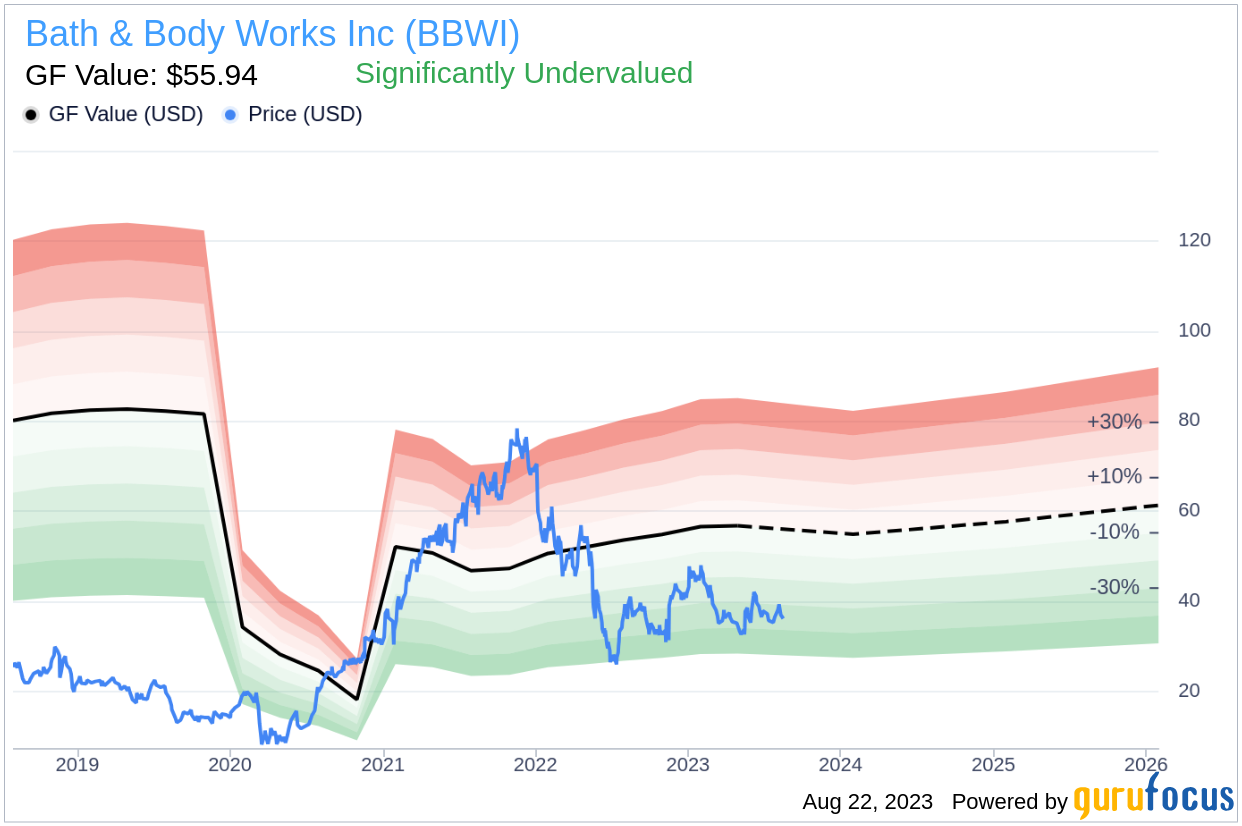As of August 22, 2023, Bath & Body Works Inc (BBWI, Financial) experienced a daily loss of -3.47% and a three-month loss of -6.59%. With an Earnings Per Share (EPS) (EPS) of 3.16, the question arises: Is Bath & Body Works stock significantly undervalued? This article delves into a comprehensive valuation analysis to provide an answer. Keep reading to understand the financial health, growth prospects, and intrinsic value of Bath & Body Works.
About Bath & Body Works Inc
Bath & Body Works is a specialty home fragrance and fragrant body care retailer operating under the Bath & Body Works, C.O. Bigelow, and White Barn brands. The company generates most of its business in North America, with less than 5% of sales from international markets in fiscal 2022. For fiscal 2022, 72% of sales stemmed from the brick-and-mortar network, which was composed of more than 1,800 retail stores. Future growth is expected from store reformatting, digital and international channels, as well as new category expansion.
Understanding the GF Value
The GF Value is a proprietary measure that represents the current intrinsic value of a stock. It is computed based on historical trading multiples, a GuruFocus adjustment factor based on past returns and growth, and future estimates of the business performance. The GF Value Line provides a visualization of the stock's ideal fair trading value.
According to the GF Value, Bath & Body Works appears to be significantly undervalued. This estimation is based on historical multiples, an internal adjustment based on the company's past business growth, and analyst estimates of future business performance. If the share price is significantly above the GF Value Line, the stock may be overvalued and have poor future returns. On the other hand, if the share price is significantly below the GF Value calculation, the stock may be undervalued and have higher future returns. At its current price of $ 35.45 per share, Bath & Body Works stock shows every sign of being significantly undervalued.
Because Bath & Body Works is significantly undervalued, the long-term return of its stock is likely to be much higher than its business growth.
Link: These companies may deliver higher future returns at reduced risk.
Financial Strength of Bath & Body Works
Investing in companies with poor financial strength has a higher risk of permanent loss of capital. Thus, it is important to carefully review the financial strength of a company before deciding whether to buy its stock. Looking at the cash-to-debt ratio and interest coverage is a great starting point for understanding the financial strength of a company. Bath & Body Works has a cash-to-debt ratio of 0.18, which is worse than 71.52% of 1092 companies in the Retail - Cyclical industry. GuruFocus ranks the overall financial strength of Bath & Body Works at 4 out of 10, which indicates that the financial strength of Bath & Body Works is poor.
This is the debt and cash of Bath & Body Works over the past years:
Profitability and Growth
Investing in profitable companies carries less risk, especially in companies that have demonstrated consistent profitability over the long term. Typically, a company with high profit margins offers better performance potential than a company with low profit margins. Bath & Body Works has been profitable 9 years over the past 10 years. During the past 12 months, the company had revenues of $7.50 billion and Earnings Per Share (EPS) of $3.16. Its operating margin of 17.01% is better than 90.3% of 1093 companies in the Retail - Cyclical industry. Overall, GuruFocus ranks Bath & Body Works's profitability as strong.
One of the most important factors in the valuation of a company is growth . Long-term stock performance is closely correlated with growth according to GuruFocus research. Companies that grow faster create more value for shareholders, especially if that growth is profitable. The average annual revenue growth of Bath & Body Works is18.6%, which ranks better than 79.87% of 1043 companies in the Retail - Cyclical industry. The 3-year average EBITDA growth is 7.1%, which ranks worse than 52.33% of 902 companies in the Retail - Cyclical industry.
ROIC vs WACC
Another way to look at the profitability of a company is to compare its return on invested capital and the weighted cost of capital. Return on invested capital (ROIC) measures how well a company generates cash flow relative to the capital it has invested in its business. The weighted average cost of capital (WACC) is the rate that a company is expected to pay on average to all its security holders to finance its assets. We want to have the return on invested capital higher than the weighted cost of capital. For the past 12 months, Bath & Body Works's return on invested capital is 27.45, and its cost of capital is 9.52.
The historical ROIC vs WACC comparison of Bath & Body Works is shown below:
Conclusion
Overall, Bath & Body Works (BBWI, Financial) stock shows every sign of being significantly undervalued. The company's financial condition is poor and its profitability is strong. Its growth ranks worse than 52.33% of 902 companies in the Retail - Cyclical industry. To learn more about Bath & Body Works stock, you can check out its 30-Year Financials here.
To find out the high quality companies that may deliver above average returns, please check out GuruFocus High Quality Low Capex Screener.




